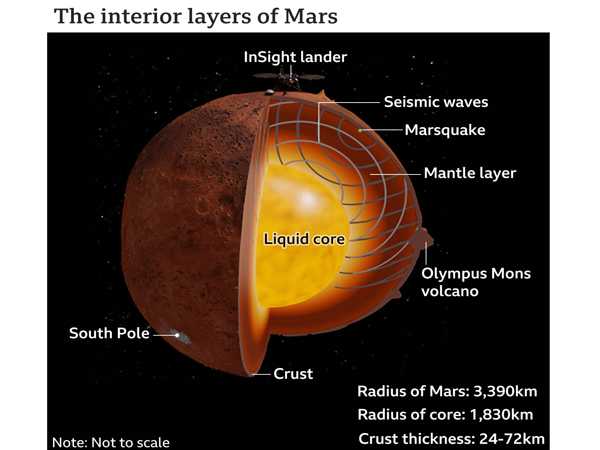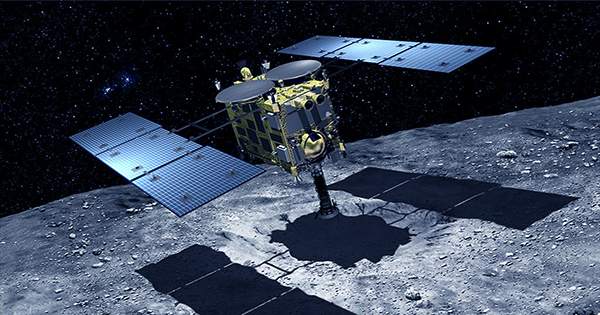For the first time, scientists have been able to look inside Mars using seismic data. They measured the crust, mantle, and core to determine their composition. As part of the InSight mission, researchers have been recording and analyzing marsquakes since early 2019. This is based on a seismometer, the data acquisition and control electronics of which were developed at ETH Zurich. The researchers have now measured the red planet’s crust, mantle, and core data, which will aid in determining the formation and evolution of Mars and, by extension, the entire solar system.
Mars once completely molten
We know that Earth is made up of shells: a thin crust of light, solid rock encircles a thick mantle of heavy, viscous rock, which in turn encircles a core primarily composed of iron and nickel. Terrestrial planets, such as Mars, are thought to have a similar structure. “Now seismic data has confirmed that Mars was presumably completely molten before dividing into the crust, mantle, and core we see today, but that these are different from Earth’s,” says Amir Khan, a scientist at ETH Zurich’s Institute of Geophysics and the University of Zurich’s Physics Institute.
Together with his ETH colleague Simon Stähler, he analyzed data from NASA’s InSight mission, in which ETH Zurich is participating under the leadership of Professor Domenico Giardini.
Researchers have been recording and analyzing marsquakes as part of the InSight mission. This relies on a seismometer whose data acquisition and control electronics were developed at ETH Zurich.
No plate tectonics on Mars
The Martian crust beneath the probe’s landing site near the Martian equator is between 15 and 47 kilometers thick, according to the researchers. Such a thin crust must contain a relatively high proportion of radioactive elements, calling previous models of the entire crust’s chemical composition into question.
The mantle, which is made up of more solid rock and extends 400-600 kilometers beneath the crust, is twice as deep as the Earth’s. This could be because Mars now has only one continental plate, as opposed to Earth’s seven large mobile plates. “The thick lithosphere fits well with Mars’ model as a ‘one-plate planet,'” Khan concludes.
The measurements also show that the Martian mantle is mineralogically similar to the upper mantle of the Earth. “In that regard, the Martian mantle is a simplified version of the Earth’s mantle.” Seismology, on the other hand, reveals differences in chemical composition. The iron content of the Martian mantle, for example, is higher than that of the Earth’s. However, theories about the complexity of the layering of the Martian mantle are also dependent on the size of the underlying core, and researchers have reached new conclusions in this area as well.

The core is liquid and larger than expected
The Martian core has a radius of about 1,840 kilometers, which is about 200 kilometers larger than was assumed when the InSight mission was planned 15 years ago. Using seismic waves, the researchers were able to recalculate the size of the core. “Now that we know the radius of the core, we can calculate its density,” Stähler says.
“If the core radius is large, the core density must be relatively low,” he explains, “which means the core must contain a high proportion of lighter elements in addition to iron and nickel.” These include sulphur, oxygen, carbon, and hydrogen, and account for an unexpectedly large proportion of the total. According to the researchers, the composition of the entire planet is still unknown. Even if Mars no longer has a magnetic field, current investigations confirm that the core is liquid, as suspected.
Reaching the goal with different waveforms
The new findings were obtained by analyzing various seismic waves produced by marsquakes. “We could already see different waves in the InSight data, so we knew how far away these quake epicenters on Mars were from the lander,” Giardini says. To be able to speak about the inner structure of a planet, quake waves must be reflected at or below the surface or at the core. For the first time, researchers have been able to observe and analyze such waves on Mars.
“The InSight mission provided a once-in-a-lifetime opportunity to collect this data,” Giardini says. The data stream will be terminated in a year when the lander’s solar cells no longer produce enough power. “But we’re far from finished analyzing all of the data — Mars still befuddles us, most notably whether it formed at the same time and from the same material as our Earth.” It is critical to understand how Mars’ internal dynamics caused it to lose its active magnetic field and all surface water. “This will give us an idea of whether and how these processes are happening on our planet,” Giardini says. “That’s why we’re on Mars: to study its anatomy.”
















